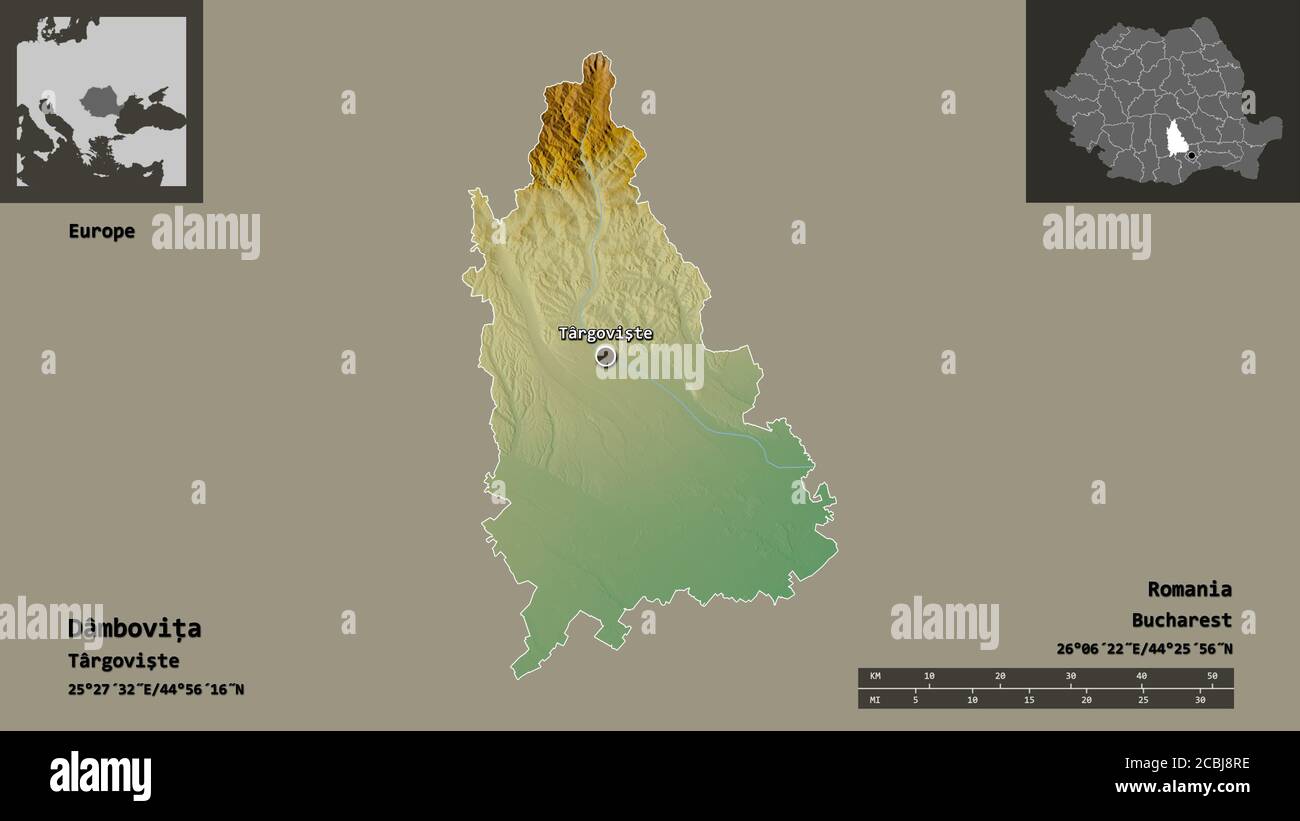Dâmbovița County (Romanian pronunciation: [ˈdɨmbovitsa] ; also spelt Dîmbovița) is a county (județ) of Romania, in Muntenia, with the capital city at Târgoviște, the most important economic, political, administrative and cultural center of the county. It is a traditional administrative unit, first attested in 1512.
Demographics
In 2021, it had a population of 479,404 and the population density was 120/km2. It is one of the most densely populated counties in Romania.
- Romanians – 87.09%
- Roma - 3.96%
- Bulgarians - 0.31%
- Serbians 0.1%
- Others - 0.13%
- Unknown - 8.41%
Name
The county is named after the Dâmbovița River, which is a name of Slavic origin, derived from Дъб, dâmb, meaning "oak", as it once flowed through the oak forests of the Wallachian Plain.
Geography
Dâmbovița county has a total area of 4,054 km2 (1.7% of the country's surface). It is situated in the south-central part of the country, on the Ialomița and Dâmbovița river basins.
The highest altitude is Omu Peak (2505 m) in the Bucegi Mountains, while the lowest is between 120–125 m, in the Titu Plain. The administrative units of the county are: 2 municipalities, 5 cities, 82 communes, all encompassing an additional 361 villages.
Neighbouring counties
- Brașov County in the North.
- Prahova County in the East.
- Ilfov County in the South-East.
- Teleorman County and Giurgiu County in the South.
- Argeș County in the West.
Economy
One of the biggest steel factories in Romania is located In Târgoviște. Also, oil is extracted and refined in the county.
The predominant industries in the county are:
- Metallurgical industry.
- Oil extraction equipment.
- Food industry.
- Home appliances.
- Textile industry.
- Chemical industry.
- Construction materials industry.
Tourism
The main tourist destinations are:
- The city of Târgoviște – the ancient capital of Muntenia.
- The Pucioasa Resort.
- The Ialomița River Valley - filled with holiday resorts, camping sites, waterfalls and natural reserves.
- The Babele and Bucegi Sphinx.
Trivia
- Glod, a small village in this area, was used to represent Kazakhstan in the filming of the mockumentary movie Borat: Cultural Learnings of America for Make Benefit Glorious Nation of Kazakhstan.
- Its capital, Târgoviște, was the seat of Vlad the Impaler, the namesake of Bram Stoker's Dracula.
Politics
The Dâmbovița County Council, renewed at the 2020 local elections, consists of 34 counsellors, with the following party composition:
Administrative divisions
Dâmbovița County 2 municipalities, 5 towns and 82 communes
- Municipalities
- Moreni
- Târgoviște – county seat; population: 79,610 (as of 2011)
- Towns
- Fieni
- Găești
- Pucioasa
- Răcari
- Titu
Historical county
Historically, the county was located in the central-southern part of Greater Romania, in the northern part of the historical region of Muntenia. The county included a large part of the present county. It was bordered to the west by the counties of Muscel and Argeș, to the north by Brașov County, to the east by Prahova County, and to the south by the counties of Ilfov and Vlașca.
Administration
The county was originally divided administratively into six districts (plăși):
- Plasa Finta, headquartered at Finta
- Plasa Găești, headquartered at Găești
- Plasa Pucioasa, headquartered at Pucioasa
- Plasa Târgoviște, headquartered at Târgoviște
- Plasa Titu, headquartered at Titu
- Plasa Voinești, headquartered at Voinești
Subsequently, the territory of the county was reorganized into eight districts by the abolition of Plasa Finta and the establishment of three new districts in its place:
- Plasa Bilciurești, headquartered at Bilciurești
- Plasa Bogați, headquartered at Bogați
- Plasa Ghergani, headquartered at Ghergani
Population
According to the 1930 census data, the county population was 309,676 inhabitants, ethnically divided as follows: 96.9% Romanians, 2.1% Romanies, 0.2% Jews, 0.2% Hungarians, 0.1% Germans, as well as other minorities. From the religious point of view, the population was 98.9% Eastern Orthodox, 0.3% Roman Catholic, 0.3% Jewish, 0.1% Adventist, 0.1% Greek Catholic, as well as other minorities.
Urban population
In 1930, the county's urban population was 33,398 inhabitants, comprising 63.2% Romanians, 2.0% Jews, 1.3% Romanies, 1.2% Hungarians, 0.5% Greeks, as well as other minorities. From the religious point of view, the urban population was composed of 94.8% Eastern Orthodox, 2.1% Jewish, 1.5% Roman Catholic, 0.6% Greek Catholic, 0.3% Calvinist, 0.3% Lutheran, as well as other minorities.
References
External links




